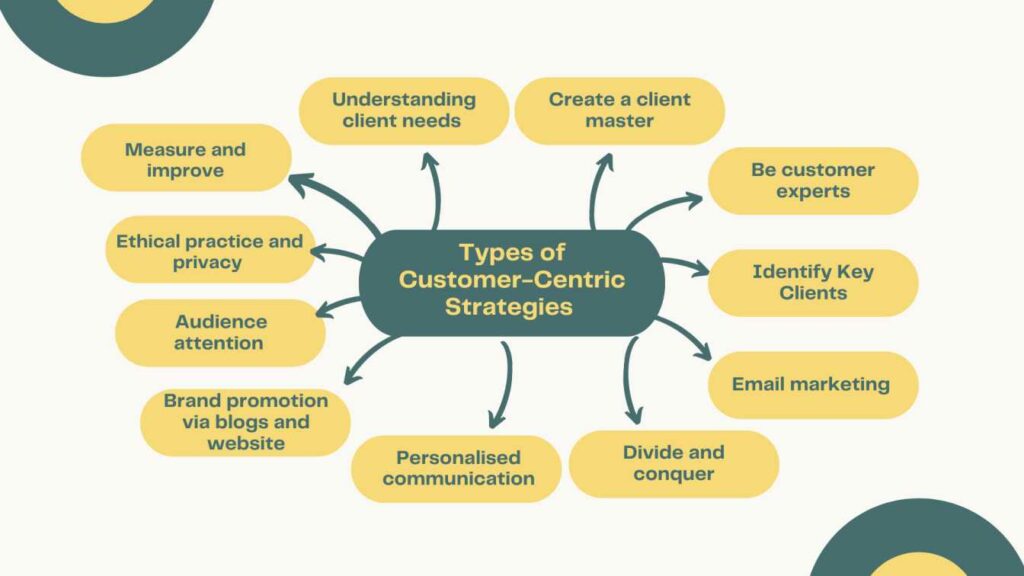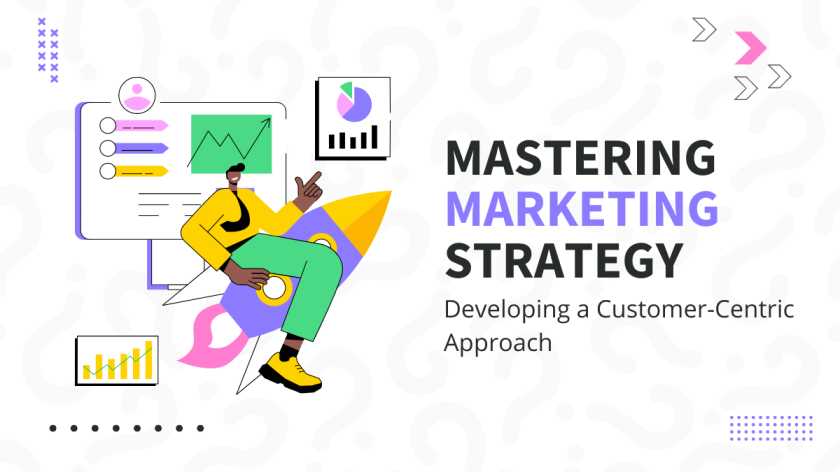Last updated on July 25th, 2024 at 11:01 am
Reading Time: 6 minutesA meaningful marketing strategy must follow the manufacturing of a product. Earlier when competition was not that fierce, the manufacturers adopted the push-sale method as a standard strategy to increase revenue. The needs of the customer were not taken seriously.
However, today’s world has changed drastically. There are many manufacturers for a similar product and each one is vying to carve out a reasonable market share for them. Thus, traditional business decisions have made their way for a more customer-centric and rational approach.
Subsequently, the management has learnt to develop and hone leadership skills for long-term sustainability. The new method researches customer feedback and analyses their expectation and wish lists. The sole purpose of this activity is to render proactive and value-added services to increase market share.
Customer-Centric approach
The customer-centric approach in marketing strategy is a scientific, measurable and result-oriented approach towards business that prioritises client needs and emotions and adjusts operational activities accordingly. This modern-day business thinking increases both revenue and profitability for a business house.
Challenges to Customer-Centric Approach
Shifting from the age-old traditional marketing practices to the modern age customer-centric strategies comes with its own set of challenges. In this section let us discuss the most common roadblocks faced by organisations in the transformation process –
Working in siloes
Due to a lack of proper guidance and/or leadership skills, departments often work in silos. This unwarranted isolation results in poor teamwork and affects inter-department communication. Thus, important business-related points are disregarded. Some of the typical examples of silo-based working are as follows –
- The marketing team sometimes make the error of focusing on business prospects without inputs from the product or service team.
- The product team sometimes skip sharing the latest or updated information with the marketing or sales team.
- The operation team may choose delivery timelines as the main mantra, ignoring valuable customer inputs/complaints.
These process gaps may be bridged through practical training sessions and upon developing leadership skills.
Lack of transparent communication
Transparent, meaningful and timely communication can always help build up a robust customer relationship. However, confusion, lack of complete information and hesitation sometimes prove to be roadblocks.
Technical complexity
Technology solutions are at times complex and may generate frustration among clients. Proper training and handholding are required to tackle this situation.
Different Types of Customer-Centric Strategies

There are quite a few customer-oriented strategies which are doable, measurable and give positive results. A proper methodology backed up by strong marketing strategy and leadership skills can make a difference. Teamwork is the basic essence of success.
The best strategies are as follows –
Understanding client needs
A business house must understand its customer’s needs. Products or services should be tailor-made according to those requirements. This in turn would increase customer loyalty.
Create a client master
In line with how a bank asks for KYC, a business house also must create a customer data bank and update it with all the minute details.
Be customer experts
Assessing customer’s minds is an important marketing strategy. Organisations must have dedicated key account managers to handle and focus on key customers. The sole purpose is to act proactively in case of any upcoming changes in client requirements.
Identify Key Clients
As a good practice in marketing strategy, it is required to identify key clients, who contribute substantially to the growth of the organisation. Such customers must be nurtured with care. They should be made feel special.
Email marketing
It is a brilliant idea to keep in constant touch with clients. Physical meetings are not possible always. As an alternative, communication through emails may be thoroughly explored. Emails should be informative about new products and must also address service-related issues with equal promptness.
Divide and conquer
Jobs must be outsourced to reliable vendors when the maximum capacity of the organisation is reached. However, it is important to control the vendor in terms of quality and timeliness. Thus, here the marketing strategy is to divide the job within departments and vendors and conquer client satisfaction. Organisational leadership skills can make it a reality.
Personalised communication
Personalised emails work much better than general group emails. This makes the client feel important. They also respond to such communication positively.
Brand promotion via blogs and website
In today’s digital world, promotion blogs and product or service awareness videos are commonly used marketing strategies. Tech-savvy clients can get the latest updates at their fingertips. An updated user-friendly optimised website is also a key requirement for a business house to grow.
Audience attention
Paying heed to reviews and online comments enhances client centricity. Asking questions to the target audience also helps in value addition.
Ethical practice and privacy
An organisation should maintain ethical practices, in in-line with the best business policies and laws of the land. Client data should be protected at all costs and hence privacy is a concern. Organisations must have multi-layered cyber security data protection.
Measure and improve
All action plans are measurable to pursue excellence. Key performance indicators (KPIs) are to be established for client-centric initiatives. Working out on metrics like CSAT (customer satisfaction scores) and NMPS (net promoter scores) will help the organisation to improve and grow.
Read more about Growth Hacking tips to power and improve your business tactics.
Benefits of Customer-Centric Approach
The business house can stay prosperous if its clients are satisfied. Customer-centric approach fosters business growth besides bringing customer delight. The benefits achieved thereof are as follows –
Build client relationships
With consistent value-added products or services, client loyalty is achieved. Efficient leadership skills lead to smarter business relationships.
Increase revenue
Happy customers do not mind paying premiums on repeat orders. Thus, revenue increases.
Reduce costs
Marketing expenses for survey and trial processes are reduced following customer-centric policies. Product and service reviews also reduce marketing costs.
Increased profitability
Profitability increases as cost reduces.
Better client retention
Delighted customers stay associated for a longer period. Client retention is a qualitative index for measuring business success.
Better competitive edge
Client-centric marketing always has an advantage over traditional marketing processes.
Leadership Skills
Leadership skills refer to some core strengths within individuals who form an integral part of an organisation’s management. People with leadership skills can make result-oriented decisions and motivate their team members to implement through hierarchy. Top leadership skills examples are as follows –
Clear and crisp communication
This is one of the best leadership skills examples. Effective verbal and written communication from leaders creates a road map for employees.
Recognising potential
Leaders should be able to recognise prospects – both for business and internal resources.
Strategic and critical thinking
One of the most important leadership skills examples is to devise a proven result-oriented business strategy. Leaders must possess critical thinking ability.
Prioritising and time management
Leaders must be good time managers. Thus, picking up jobs with priorities is among the key leadership skills.
Risk-taking appetite
Management demonstrates leadership skills by taking calculated risks for prosperity and growth.
Creativity, positivity and flexibility
Leaders should have creative business solutions. They must take challenges positively and be flexible in their approach.
Feedback seeking and conflict resolution
Leaders should be employee-oriented. They must consider feedback from all concerned for conflict resolution.
Mentorship and dependability
Leaders should be mentors to employees. They are dependable for ultimate organisation goals.
Delegation
One of the key leadership skills examples is the delegation of duties and authority to deserving employees.
Team building
Team building must be a natural habit of a leader.
CMO Program
Nowadays, an organisation’s success is synonymous with the quality of leadership its management showcases. The Chief Marketing Officer program, abbreviated as the CMO program is an essential curriculum for all future leaders, pursuing marketing as their subject.
Several great institutions and established organisations have come up with their own CMO program. The program delves into extensive research and modern trends in marketing. It creates unique development opportunities for leaders.
Conclusion
Nowadays true market leaders must be multifaceted, technology and powerful brand ambassadors. They must be customer-centric, excellent narrators of success stories and growth drivers. The CMO program ensures leadership skills for future leaders.
The Global Senior Leadership Programme Specialisation: Chief Marketing Officer by Imarticus will give prospective candidates massive growth at the beginning of their careers. The duration of the course is 6 months.
Visit the official website of Imarticus for more details.
FAQs
- What are KPIs?
KPIs refer to Key Performance Indicators that are established to measure the level of excellence achieved.
- Why is developing a proper website an important customer-centric marketing strategy?
An updated user-friendly optimised website is very important as customers can get the updates at their fingertips.
- What are the two most important customer-centric approaches in marketing strategies?
Understanding the needs of the customers and creating a client master are the two most important customer-centric approaches in marketing strategies.
- What are the two main KPIs?
KPIs like CSAT (customer satisfaction scores) and NMPS (net promoter scores) will help the organisation to improve and grow.

